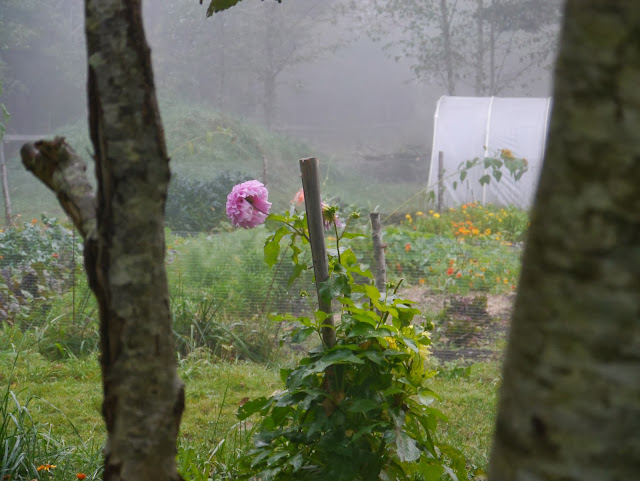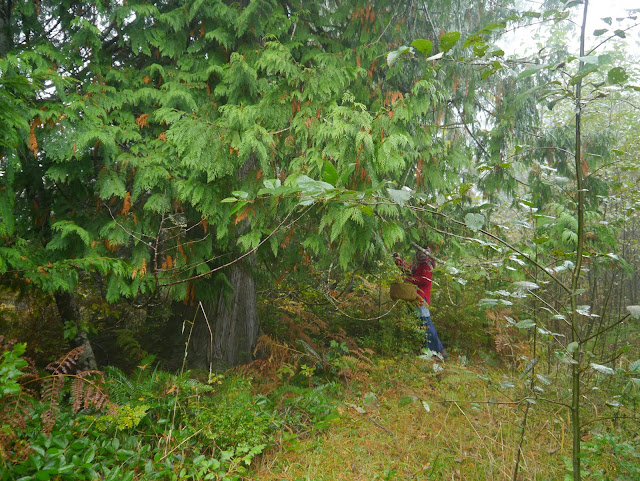I went to Honey Grove to create the latest Gray Fox Epistle (arriving in subscriber's post boxes the 4th or so of November!), set not in my native California, but there, in the boundary between the wild woods of Vancouver Island, and the haven of peace and cultivation and sacredness that is Honey Grove. I went there to be like the honeybee, gathering the pollen of a new place in my writer's hands, into my heart. I went, and I crossed my fingers that I would be able to write anything at all.
The experience was more beautiful than I could have possibly hoped. As I mentioned a few posts ago, the first morning Nao let me taste the honey from her holy bees, and then a bit of propolis (the antibacterial, antiviral, resinous material they make from ingesting tree sap-- mainly fir or cedar around here-- which they then use to seal up their hives), and finally a spoonful of pollen (like little beach pebbles). It felt like a baptism into the landscape, into the world known and loved (literally) by the Honey Grove Bees.
Below, my dear readers, is a little taste of the pollen I gathered, which indeed became an Epistle, currently out in the mail-webs, traveling to meet the hands of its subscribers! That Epistle was written early in the mornings, before light, when I was still drifting near dreams. I ate a little honey each morn to make sure I had the bee-magic in me as I wrote. When it got light, I shared breakfast with my new friends, and the magic of the day began.
I've learned, the more I write, the more deeply woven into that craft and art I become, that writing is as much about Being Present in the World as it is about sitting at the desk and doing it, pen to paper. You have to go out, penless and paperless, and Be, in order to have something to tell of. You (at least I) need to feel some deep wonder at the world, and deep curiosity, at its every particular, otherwise what is there to say?
Without further ado, the pollen:
Cold mists gathered low each morning, walking the ground with silver feet.
The sun came to burn them off, but the mist liked to stay a bit longer on the spider strings.
Emmett the duck took good care of his ladies in the duck-pen, and showed off his lovely wing feathers to us as we passed. In the Epistle, there is a woman with a goose foot, orange as Emmett's...
The autumn vegetables, the last raspberries, the richness of this land that Nao and Mark cultivate is truly profound. And when you are amidst it, you can feel it positively pulsing with the Love they have put into its tending. I've never been anywhere like it, so suffused with this kind of care and creativity. Honey Grove felt to me like a work of art, in the best possible sense-- a place created from the deep wellsprings of all sacred creativity and knowledge of the lives of Plants, a place also engaged in a deep and respectful conversation and relationship with the wild woods around it, with the soil, with the air. And Nao and Mark its gate-keepers, its edge-walkers, its parents and its friends and its students.
Nao planned a small Gray Fox Epistles reading with a handful of her friends. I pored over her collection of my Epistles with a morning cup of tea, trying to decide what to read, and having a bit of trouble!
I've never gotten to see all the Epistles at the Other End, when they reach their readers at far corners of the globe, mail-battered, lovingly read. A delight!
And yes, in case you were wondering, this cake was even better than it looks. Oh my heavens. The ideal tea-cake, in my opinion, wreathed in garden-picked calendula.
Then we wandered off to gather beautiful bits of the forest for a small altar, the Land Around Us deserving a place at the reading too, as it is always the ultimate Pollen to me when I write-- the movings and livings of the wild world.
Gus the magical dog, of course, accompanied us with much aplomb, and the expectation of at least a few treats. He is just the sort of companion you hope for on a misty walk, snuffing and frisking about and making sure you remember to poke around in the bushes too.
I love that one of the only ways to really see the individual drops of mist is on a spiderweb. Two of the most delicate miracles in the world-- mist and spidersilk-- together. In the Epistle, there are misted threads of spider-line, and there are pearl necklaces scattered in moss just so...
Nao (above) and I both wore red coats, because it is hunting season. I'm not used to wearing red, and I realized as I walked what an invigorating color it is. A powerful color, as a woman, the red of menstrual blood, life-force. I associate red with mythic tales-- red coats and capes and vests and skirts and hats. Somehow it leant that essence to our walk, which felt like a walk out of Time, into the soft Magic of the Land, and back again (to eat our spice cake....)
I couldn't stop marveling at the red cedars, which we don't have in my part of coastal California. They feel like very feminine motherly trees to me, with the most delicious gentle smell to their scaly needles. Above, Nao gathers a few fronds. When I look at this photo now, as I thought at the time, the tree feels like a big wise old lady, leaning down in a maternal way to let Nao take a few bits of green.
For thousands of years, in First Nations cultures, the cedar has been one of the most important, and most holy trees, used to make a huge range of items, from canoes to longhouses, baskets and clothing and rope from the bark, medicine, capes, masks... Virtually every part of this powerful tree was used, to such a degree that the cedar is referred to as the Tree of Life to many Pacific Northwest native peoples. Meeting it here, I can see why.
I gathered some feathery fronds as well, to take home with me and to nibble at (they taste divine).
This silvery cedar bark seems to have been pecked by what looks to me to be some sort of sapsucker (they wood-peck in straight lines like that)-- perhaps a red-breasted sapsucker, which according to my research resides year-round on Vancouver Island. Amazing, to imagine a bird designed to drink the sap from trees-- I imagine cedar sap is delicious, and I wonder if the bees gather it for their propolis.
We gathered fern-moss when we entered the damp forest...
.... and marveled at the lacy edges of mushrooms, dark and wise underground beings who know of decay and of regeneration....
.... the red of the old amanita, dangerous mushroom of shamanic hallucination, of Viking beserker rages, of fairy-tale temptations.
Back in the cottage, we laid our altar, we drank tea, we ate spice cake, I read a quilted patchwork from two Epistles to the little gathering of women.
We were both aglow, when the guests left, with the magic of it all.
And all of these things in one way or another were gathered in my red notebook, where all my story-writing occurs-- the hive where I put the honey, the pollen, the propolis. The story-Epistle that emerged, which is a retelling of the Grimm's Queen Bee, at once Is, and Is Not, of this place. It is not Merville (the township where Honey Grove resides), and yet it is. It is not exactly these fir and cedar woods, and yet it is... and so it goes with all tales.
But the Bees, well, they are always and only the Bees, nothing else. They are the true carriers of the tale, and of all the stories of this landscape. I am so grateful to have met them, and I am so grateful to Nao and to Mark and to Gus, and to all the beings of Honey Grove, for such a perfect visit.























































